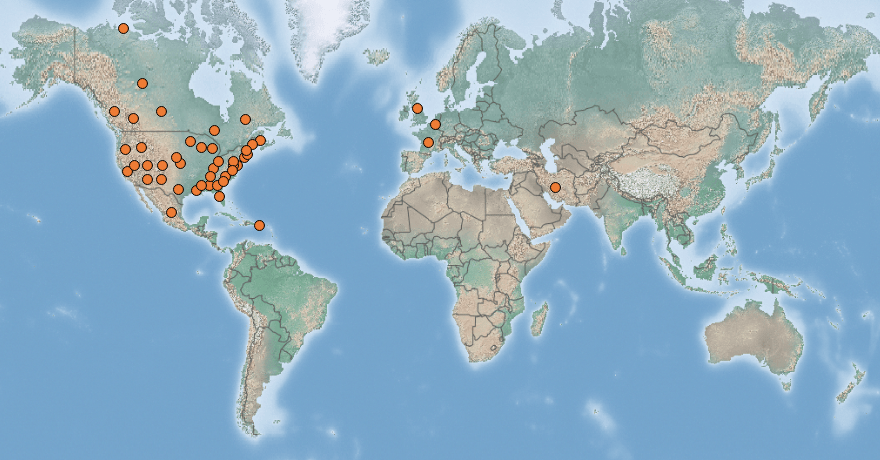 |
Fathead minnow | Status LU: casual. 1st record: ~1996. |
 |
Amerikaneschen Déckkapp-Dreckseller1 | Status Eur.: established. |
 |
Tête de boule | RA: ISEIA: C0. Harmonia+: n/a. |
 |
Amerikanische Dickkopfelritze | Wikipedia: |
 |
Amerikaanse dikkop-elrits | Back to the list of vertebrates |
Contents
Report the species
→ Report Pimephales promelas to the National Museum of Natural History.
Brief description
 Pimephales promelas (Rafinesque, 1820), commonly known as the fathead minnow, is a small-bodied, short-lived, nest guarding cyprinid fish. It is one of the most widely distributed fishes in North America and its native range covers large expanses from the Rocky Mountains in Canada south to Texas and northern Mexico. It has been accidently or intentionally introduced to many areas, where it has been stocked for its use as bait or as an aquarium pet. It is tolerant of a range of environmental conditions, has a high reproductive output and consumes a variety of food resources. It therefore has a high invasive potential and has been recorded as a pest in many countries. It is known to cause declines of native and endangered species including Colorado pikeminnow (Ptychocheilus lucius), the Lost River sucker (Deltistes luxatus) and shortnose sucker (Chasmistes brevirostris) in Oregon and California. It has also negatively impacted habitats, such as wetlands in the Prairie Pothole Region, USA. In Europe, its introduction has resulted in the spread of enteric redmouth disease through the introduction of a bacterial pathogen (Yersinia ruckeri) (CABI 2019).
Pimephales promelas (Rafinesque, 1820), commonly known as the fathead minnow, is a small-bodied, short-lived, nest guarding cyprinid fish. It is one of the most widely distributed fishes in North America and its native range covers large expanses from the Rocky Mountains in Canada south to Texas and northern Mexico. It has been accidently or intentionally introduced to many areas, where it has been stocked for its use as bait or as an aquarium pet. It is tolerant of a range of environmental conditions, has a high reproductive output and consumes a variety of food resources. It therefore has a high invasive potential and has been recorded as a pest in many countries. It is known to cause declines of native and endangered species including Colorado pikeminnow (Ptychocheilus lucius), the Lost River sucker (Deltistes luxatus) and shortnose sucker (Chasmistes brevirostris) in Oregon and California. It has also negatively impacted habitats, such as wetlands in the Prairie Pothole Region, USA. In Europe, its introduction has resulted in the spread of enteric redmouth disease through the introduction of a bacterial pathogen (Yersinia ruckeri) (CABI 2019).
Status and distribution in Luxembourg
In Luxembourg, Pimephales promelas (Rafinesque, 1820) was first documented during a species inventory in 1996/1997 (Administration des eaux et forêts 1998). Five individuals were caught in three different spots (Lower Sauer, Alzette and Diddelengerbaach). These occurrences are probably due to the animals’ use as live bait or the release of aquarium fish.
During an identical inventory in 2005, the species was not found in Luxembourgian watercourses anymore (Administration de la gestion de l’eau 2010).
There is no distribution map available because no data has been entered into the Recorder-Lux database so far (MNHNL, iNaturalist & GBIF 2019).
Risk assessment
ISEIA protocol
C01 (1+1+1+1) (Ries et al. 2014: 199).
Harmonia+ protocol
Not assessed yet.
Worldwide distribution
Bibliography
- Administration des eaux et forêts, Service de la Chasse et de la Pêche (1998): Fische in Luxemburg, Kartierung der Fische, Neunaugen und Flußkrebse des Großherzogtums Luxemburg, ISBN: 2-495-28004-8, 153 pp.
- Administration de la gestion de l’eau (2010): Les poissons au Luxembourg, Cartographie des poissons, lamproies et écrevisses du Grand-Duché de Luxembourg, 2ième édition, ISBN: 978-2-91989-713-1, 213 pp.
- CABI, 2019. Pimephales promelas (Rafinesque, 1820). In: Invasive Species Compendium. Wallingford, UK: CAB International. URL: www.cabi.org/isc [accessed 2020-04-22]
- Klees, H., 1981. Luxemburger Tiernamen. Beiträge zur luxemburgischen Sprach- und Volkskunde XIV. Institut grand-ducal, Section de linguistique, de folklore et de toponymie. 2. Aufl. 131 S. Imprimerie Pierre Linden, Luxembourg.
- MNHNL, iNaturalist & GBIF, 2019. MNHNL-mdata, online portal combining species observation from Recorder-Lux, iNaturalist and GBIF. National Museum of Natural History, Luxembourg. URL: https://mdata.mnhn.lu [Accessed 2019-10-24]
- Ries, C., M. Pfeiffenschneider, Engel, E., J.-C. Heidt & M. Lauff, 2014. Environmental impact assessment and black, watch and alert list classification after the ISEIA Protocol of vertebrates in Luxembourg. Bull. Soc. Nat. luxemb. 115: 195-201. [PDF 247 KB]
Suggested citation of this webpage
Ries, C. & M. Pfeiffenschneider (Eds.), 2025. Pimephales promelas (Rafinesque, 1820). In: neobiota.lu - Invasive Alien Species in Luxembourg. National Museum of Natural History, Luxembourg. URL: https://neobiota.lu/pimephales-promelas/ [Accessed 2025-12-17].
Page content last updated on 2020-04-23. Last proofread by Caroline Grounds on 2019-11-28.
- Elritze cf. Klees 1981: 27.[↩]


